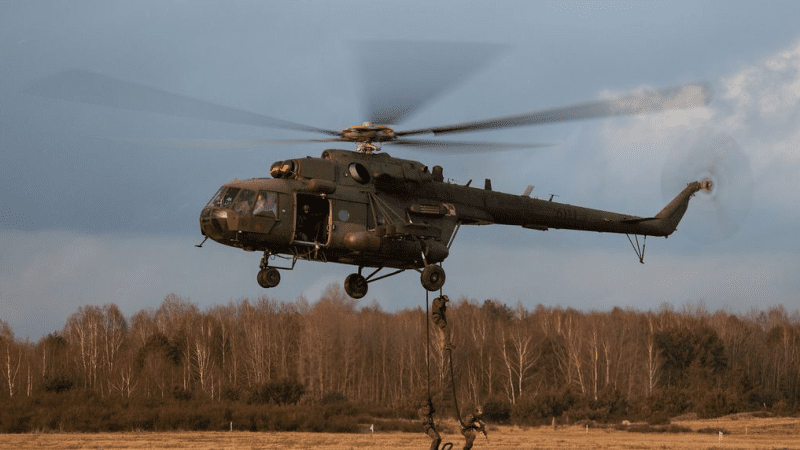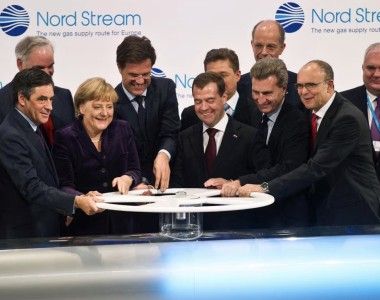Replacement of Russian Helicopters in the European Armed Forces [ANALYSIS]

The problem tied to post-Soviet helicopters is one related to the long-term effects of the war in Ukraine. Poland operates the largest Mi-8/17, Mi-14, and Mi-24 fleet in the region, but more than 240 helicopters as such are operated by the NATO/EU armed forces. Meanwhile, it is impossible to source spare parts from Russia, for obvious reasons, with the same applying to the Ukrainian counterparts. A problem emerges, that seriously hampers the operational capabilities of the armed forces of several European states. It is a much greater challenge, globally speaking.
The War in Ukraine has had an impact on the armed forces globally, with that impact being impossible to predict. Apart from major defence spending increases, problems also emerged in the area of military procurement. On one hand, this is caused by a demand that exceeds the supply/stockpile. On the other hand, Russia has been subjected to sanctions, also in a role of a supplier. Numerous users of the Russian and post-Soviet equipment look to the future with worries.
Major losses the Russian Army Aviation is suffering from are also meaningful here. Ever since the start of the war in February, the Russians have lost more than 160 helicopters, including some of the latest Ka-52 and Mi-28N attack helicopters. They are being shot down by MANPADS, as the ATGMs and self-defence measures marketed by the Russians are not that effective.

Photo. mil.ru
The availability of spares, munitions, or contracted deliveries may be a challenge - not only due to the ongoing conflict. Sanctions imposed on Russia are a far greater challenge - especially in the area of dual-purpose/military equipment, and especially for the European users. This applies to both procurements, as well as deliveries.
Replacements sourced from countries that were a part of the Soviet area of influence solve this problem in many respects. Poland, Bulgaria, and Serbia are known for manufacturing firearms, or ammunition, for grenade launchers, and artillery as well. Air defence systems, aircraft, or helicopters, being more advanced, also pose a greater challenge. The latter may be a source of a major crisis in CEE.
Spares? Overhauls?
Not only do components for aerospace equipment need to conform to norms and formal requirements, as the same set of norms applies to the contractors dealing with overhauls - they need to be certified. This especially applies to lifetime extension overhauls - keeping the aircraft airworthy. Apart from Russia, only a handful of businesses based in NATO countries can handle this. These include the WZL nr 1 facility in Poland. As long as spares are available, the problem is not direct, urgent, and significant.
The War in Ukraine may have an impact on this domain. The Ukrainian Motor Sich company has been the sole supplier of engines and gearboxes for Mil helicopters outside Russia so far. After 2014, the process of getting rid of Russian components began, so that it would be possible to maintain them, without sourcing anything from Russia. This also applies to key components, such as the rotor blades. In 2021 the Motor Sich company has delivered the first rotor blades to the Armed Forces of Ukraine. These were manufactured in Zaporizhzhia.

Unfortunately, the Motor Sich facility in Zaporizhzhia has been subjected to airstrikes, and it is difficult to assess the scale of losses. The Ukrainian Armed Forces are also probably the top customer now. On the other hand, Motor Sich and a local partner have been seeking opportunities to launch a manufacturing facility in Poland. On one hand, this would mean that manufacturing would be secure. On the other, it would be easier for the Ukrainian company to reach the European marketplace or the other way around. As the manufacturing would be taking place in the EU, it would be easier to get accommodated in that market. This would also mean that deliveries of engines or rotor blades would no longer pose such a challenge. However, this is just the tip of the iceberg - related to the depletion of sources of spares. Unless comprehensive solutions are devised, the Mi-8/17/24 fleets would face a prospect of cannibalization.
This means that there is a necessity to replace a whole fleet of post-soviet aircraft in the CEE region soon (speaking of years, not months here). Ultimately, Ukraine would also be decommissioning these, if it can procure or develop new aircraft, based on the available technologies. This was, and probably still is an ambitious goal of the Motor Sich facility that developed an in-depth upgrade of Mi-2 and Mi-8 helicopters, improving their performance and functionality. The latest solutions only utilize a minor part of the structural designs: this applies to the MSB-2 Nadiya. The goal was to develop proprietary light and medium helicopter designs. However, neither is that solution available nor satisfactory for the NATO member states. Meanwhile, the whole eastern flank of NATO utilizes the post-Soviet Mil helicopters.
The time has come to implement generational changes and a change of mentality. How does the situation look in Europe, when it comes to aircraft of Russian origin? The Military Balance suggests that in 2021 the numbers in CEE have been as follows:
- Bosnia and Herzegovina - 12 Mi-8s, and 1 Mi-17;
- Bulgaria - 6 Mi-24s, 5 Mi-17s;
- Croatia - 14 Mi-8s, 10 Mi-171Shs;
- Cyprus - 11 Mi-35Ps;
- Czech Republic - 16 Mi-171Ss, 10 Mi-35Ps, 7 Mi-24s, 5 Mi-17S, 4 Mi-8s;
- Hungary - 8 Mi-24s, 5 Mi-17s, and more than 10 Mi-8s kept in storage;
- Latvia - 3 Mi-8s;
- Northern Macedonia - 6 Mi-8s, 2 Mi-17s, 2 Mi-24s, 8 Mi-24s kept in storage;
- Poland - 22 Mi-24s, 22 Mi-8s, 17 Mi-17s, and 8 maritime Mi-14s;
- Serbia - 8 Mi-8s, 6 Mi-17s, 4 Mi-35Ms, 2 Mi-24s;
- Slovakia - 13 Mi-17s and more than 15 Mi-24s kept in storage.
In total, we are speaking of more than 240 helicopters, most of which remain in the active service, in the states forming the NATO Eastern Flank. This is troubling for Europe, but it would also be a loss for the Russian industry, kept away from this major market. At the same time, it is a major challenge for the users and an opportunity that numerous manufacturers have identified. Hence the intense marketing effort of the leading global companies, trying to create a major footprint in the CEE marketplace. One should note that replacement of the helicopter fleets has already been launched by a majority of countries, such as Poland, the Czech Republic, and Romania. However, the said process would now be accelerated significantly.
Multi-Role Helicopters - A Change of Concept?
"In the medium and long term, it is difficult to imagine, given the availability of spares, we would be still flying the Mil helicopters. From the doctrinal, mental, and organizational point of view, it's high time to forget the Post-Soviet platforms", said Jacek Libucha, President at PZL Świdnik, during Defence24 DAY, also recognizing the major opportunity for the manufacturers to offer alternative platforms here. Not only does it stem from the opportunity, but also from the necessity to replace whole fleets, so that they meet western standards.
PZL-Świdnik/Leonardo Helicopters and PZL-Mielec/Lockheed Martin would be fighting for the replacement of the Post-Soviet aircraft with the replacements they propose. This piece of market share would be contested in all of the aforesaid countries. Airbus Helicopters would also be involved - with no successes in Poland, Airbus managed to introduce its aircraft in Serbia, Hungary, or Bulgaria.

Photo. Министарство одбране Републике Србије
This probably does not refer to a 1:1 replacement, as it means that the whole structure shall be reformated to match the western standards. Mi-8/17, given its cargo capacity, shall be placed somewhere in between the medium and heavy cargo helicopter platforms. Meanwhile, the listed countries usually do not operate conventionally understood medium helicopters, weighing 8 to 10 tonnes. Mi-8/17 has an MTOW of 13 tonnes and a spacious cargo bay. Therefore, the Hips are less agile and larger than Black Hawk or AW-149. It is worth considering introducing aircraft like that, instead of seeking a direct Mi-8 replacement. The decision to procure AW149s for the Army Aviation in Poland seems to be a result of this mindset.
Also, when it comes to the light multi-role helicopters in Poland - this species is represented by the obsolete Mi-2 and W-3 Sokół platforms - fleet replacement is imminent. These should be replaced by modern helicopters of significant combat capabilities and low cost of operation.
Mi-24 Successor?
Replacement of the Mi-24 attack helicopters is a far more complex challenge. As the Czechs found out, seeking a replacement that would be a 1:1 solution capabilities-wise, cannot be done with a single type of aircraft. Mi-24/35 combines the capabilities of an attack helicopter and those of a utility helicopter that can carry 6 fully equipped troops. The Czechs used to use the Mi-24 for JTAC/SOF operations. They have decided to procure a tandem, formed by Bell helicopters. AH-1Z Viper plus UH-1Y Venom. Other users, seeking solely the attack helicopters, have much more to choose from.

Photo. US Navt
Here, Bell AH-1Z Viper, Boeing AH-64E Apache Guardian (Operated by US Army and British Army), and Airbus Helicopters Tiger (operated by France, Germany, and Spain) are the main contenders. Australia is replacing its Tiger fleet with Apache Guardians. In some sense, the choice is between unification with the US military or France.
Alternative solutions include the Italian AW249 or the Turkish aircraft - but so far these projects extend into the future, and thus entail a certain risk. This applies to the commissioning date, and the export sales as well.
Summing it up, the NATO Eastern Flank faces the challenge of replacing the Post-Soviet fleet of helicopters with new rotary-winged aircraft of western origin. This is a major opportunity, both for the manufacturers, as well as the aerospace industries. It gives a unique chance to launch cooperation in the implementation of those programmes, transfer of technology, and become a part of global supply chains. A well-thought-over policy adopted by the governments should facilitate such actions - as they would be viable in the longer run. At the same time, the priority shall be placed on meeting the requirements of the domestic armed forces.



